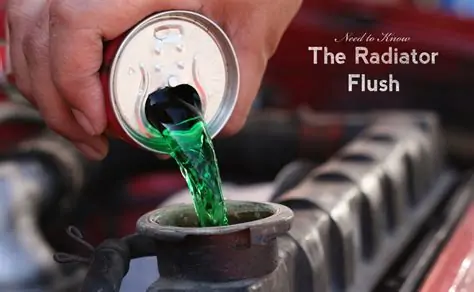Homemade Radiator Flush DIY: Safe and Effective Methods
Want to save money while keeping your car engine cool? A **homemade radiator flush** is a smart way to perform basic maintenance. Instead of paying high prices at auto shops, you can flush your radiator at home using common household products. This not only saves you money but also helps you better understand your car’s vital systems.
Why Try a DIY Radiator Flush?
Flushing helps remove damaging contaminants like rust, dirt, and scale buildup from your cooling passages. This immediately **improves cooling efficiency**, preventing engine damage. DIY methods are significantly **cheaper** than professional services, allowing you to extend your engine’s life on a budget. Furthermore, performing this task builds your confidence in basic car maintenance. For background on the chemical composition and importance of the fluids you are replacing, you can explore the Antifreeze (Engine Coolant) Wikipedia page.
Popular Homemade Radiator Flush Methods
Important Caution: Always use **distilled water** for all flushing and final mixing steps. Tap water contains minerals that can cause harmful scale buildup inside your radiator and engine block.
1. Baking Soda and Distilled Water (The Safest Method)
This method is simple and mildly alkaline, meaning it helps neutralize any residual acidity in the system. Mix 1/4 pound of **baking soda** with 1 gallon of **distilled water** and pour it into the radiator. Run the engine for 15–20 minutes with the heater on. Drain and follow up with a thorough rinse of distilled water. This is the **most recommended** DIY solution for its low risk to seals and metals.
2. Vinegar Solution (Use with Extreme Caution)
Vinegar is effective against rust and scale due to its acidity. Fill the radiator with a 50/50 mix of distilled water and white vinegar. Next, let the car run for no more than **20-30 minutes**. Afterward, drain the solution immediately. Because vinegar is acidic, **thorough rinsing is absolutely essential** to prevent corrosion of aluminum components and gaskets. We highly recommend doing a final rinse with the Baking Soda solution to neutralize any leftover acid.
3. Dish Soap Flush (For Grease and Oil Residue)
Mild dish soap (NOT automatic dishwasher detergent) is a good degreaser. Add a few drops of dish soap into the radiator with distilled water. Let it circulate for 10-15 minutes. Drain and rinse until the water runs completely clear and all soap residue is gone. This method is primarily useful if you suspect oil or grease contamination in the cooling system.
4. Lemon Juice Cleaner (Similar to Vinegar Risk)
Lemon juice contains citric acid, which can help break down scale buildup. Mix a concentrated amount of lemon juice with distilled water and run the engine for a short time (under 20 minutes). After draining, rinse the system completely. Like vinegar, you must be extremely diligent about rinsing to avoid leaving acid residue.
Step-by-Step DIY Radiator Flush
- Cool the Engine: Allow your engine to cool completely (at least an hour) before touching the cap.
- Drain Old Coolant: Place a large drain pan under the radiator. Open the drain valve (petcock) or remove the lower radiator hose and let the old coolant drain out completely.
- Add Flush Solution: Close the valve/hose and add your chosen homemade flush solution, filling the system with **distilled water**.
- Circulate the Cleaner: Run the engine for the recommended time (15–20 minutes) with the heater on max.
- Drain the Solution: Turn off the engine, let it cool again, and drain the cleaning mixture.
- Rinse Completely: Fill the system with plain **distilled water**, run the engine for 5 minutes, cool, and drain again. Repeat this step until the draining water is perfectly clear.
- Final Refill: Close the valve securely and refill with the manufacturer’s specified 50/50 mix of fresh coolant and **distilled water** (or use pre-mixed coolant).
Cost Savings and Resources
Homemade radiator flush methods are highly budget-friendly. For example, baking soda or vinegar costs less than a few dollars. This contrasts sharply with auto shops, which may charge $100 or more for the service. The DIY solution requires only your time and effort. If you want to compare DIY vs. professional service costs, check this helpful guide: Radiator Flush Cost at Valvoline.
Safety & Environmental Tips
- NEVER Open a Hot System: Always let the engine cool completely before opening the radiator cap to avoid severe burns from scalding steam.
- Wear Protection: Use gloves and safety goggles.
- Dispose Safely: **Old coolant is highly toxic.** Collect the old fluid in a sealed container and take it to a local hazardous waste center or an auto parts store for proper recycling. Never pour it down drains or onto the ground.
- No Tap Water: Always use **distilled water** for rinsing and refilling to prevent mineral deposits.
Video Guide
For a clearer demonstration of DIY radiator flushing, watch this video:
FAQ: Homemade Radiator Flush
Is it safe to use vinegar in a radiator?
Yes, but only for a short period, and you must rinse **extremely well** afterward to prevent acidity damage. A final rinse with a baking soda solution is highly recommended for neutralization.
Can baking soda damage the cooling system?
No. Baking soda is mildly alkaline and one of the safest DIY options, provided you flush it out completely.
How often should I flush my radiator?
Most experts suggest every 2–3 years or 30,000 miles. However, if you drive in harsh conditions or use basic water flushes often, more frequent replacement of the chemical coolant mix may be necessary.

